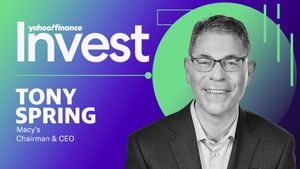Borrowers of federal student loans are once again facing changes as two debt forgiveness options are set to reopen this December. Following President Joe Biden’s recent announcement about reviving certain repayment plans, many individuals saddled with educational debt are cautiously optimistic about the potential for relief. According to recent reports, Biden's move aims to provide more accessible pathways to loan forgiveness amid uncertainties surrounding the 'Saving on a Valuable Education' (SAVE) plan, which is currently stuck in legal limbo.
The main options being reintroduced are the ‘Pay-As-You-Earn’ (PAYE) and ‘Income-Contingent Repayment’ (ICR) plans. These plans were popular before the introduction of the SAVE plan, which offered more favorable repayment terms but has been halted by judicial challenges. Now, with the future of SAVE unclear, it's clear the Department of Education (DOE) is trying to offer alternatives to help borrowers manage their payments more effectively.
"PAYE and ICR plans existed prior to the SAVE plan and had been transformed under the Biden administration," explained Alex Beene, who teaches financial literacy at the University of Tennessee. “The current situation has led the DOE to allow new enrollments again to aid those who might miss out on benefits under the existing plans.”
So what's at stake for borrowers? Well, the stakes could not be higher. The DOE has outlined substantial figures indicating around $175 billion has already been forgiven for approximately five million people under Biden’s administration. Now, with legal battles around the SAVE plan, providing alternative means for borrowers to aim for forgiveness is imperative.
A spokesperson for the DOE made the department's intentions clear: "While we defend the SAVE plan, we must also take immediate action to keep options available for borrowers, particularly those pursuing Public Service Loan Forgiveness." The interim rules will effectively allow borrowers to utilize either PAYE or ICR, facilitating their pathways toward debt relief.
Historically, borrowers have grappled with the repercussions of loan decisions, especially when financial markets fluctuate. For many, the reopening of these plans is not just news; it’s perhaps the lifeline they desperately need. Some are even hopeful as they gear up to start repaying loans again, eager to regain control over their financial futures.
Nevertheless, the impact of such strategies can have broader ramifications. With long-term interest rates maintaining high levels, borrowers have increasingly found it challenging to stay current on payments. Kevin Thompson, CEO of 9i Capital Group, emphasized this struggle, stating, "Reopening these programs addresses some inequities and provides significant relief where it’s most needed.”
Yet, the road forward could be bumpy. Beene pointed out, “This is great news for borrowers, but they may find these newly reopened programs to be short-lived.” Many observe with skepticism, as previous administrations—especially the Trump administration—have indicated resistance toward similar relief initiatives.
If Donald Trump regains the White House, experts anticipate potential alterations to these plans. During his first term, Trump favored measures increasing the percentage of discretionary income required for payments and proposed to consolidate income-driven repayment options, potentially leading to stricter repayment demands.
Compounding these developments, the Consumer Financial Protection Bureau (CFPB) has also called for significant reforms aimed at holding student loan servicers accountable. The CFPB's Annual Report highlighted over 18,000 complaints from borrowers, marking the highest tally since the agency began tracking such data. Complaints ranged from inaccurate billing and delays to inadequate customer service. This echoing lack of accountability has raised red flags, particularly as students continue to navigate payment structures fraught with challenges.
CFPB Director Rohit Chopra voiced concern: "Student borrowers have faced costly errors and unnecessary delays because of servicer failures." The call for heightened accountability highlights the necessity for enhanced oversight, especially as the current educational debt crisis looms large.
Looking broader, the specter of significant changes might soon accompany any potential alterations to federal student loan management. Should Trump’s vision for 'Project 2025'—a strategy aimed at moving management responsibilities to the Treasury—come to fruition, the phase-out of income-driven repayment plans could severely limit borrower protections. Critics of the plan argue it would create greater barriers for students seeking higher education, especially from families who currently depend on available federal loan programs.
The projected changes echo nationwide fears among low-income borrowers who could face substantial repayment increases. Formerly comfortable payment structures could transform dramatically. This move could reduce monthly payment caps and benefit fewer low-income families. Under new guidelines, borrowers might have to pay 10% of their income above the poverty line, which could intensify struggles for those who are already financially strapped.
The potential cutback or elimination of federal repayment programs—including Parent PLUS Loans and Graduate PLUS Loans—could have dire consequences for those seeking to finance both undergraduate and postgraduate education. Families who rely on these options might find themselves unable to afford rising tuition costs, creating greater divides between wealthier families and those from lower-income households.
For many students and families, hope increasingly hinges on available pathways for loan forgiveness, particularly for those working under Public Service Loan Forgiveness programs. These programs have provided students with the assurance needed to make long-term commitments, but their viability could come under threat under more stringent federal policies. Weighing the changes under Project 2025, experts warn of economically challenging times ahead for new graduates and low-income families seeking education.
Even now, with the reopening of PAYE and ICR plans, borrowers remain dubious about the sustainability of these options. Many are left grappling with what this means for the future and if they can genuinely rely on these changes to provide the relief they desperately seek.
Looking forward, millions of borrowers find themselves at the mercy of shifting policy landscapes, watching closely as the viability of these programs continues to be debated publicly. The fate of federal student loans remains uncertain, shaped by upcoming electoral processes and the broader national dialogue surrounding education funding and debt relief. For borrowers, the reality is stark: the need for clarity is urgent, and the stakes could not be more significant.



